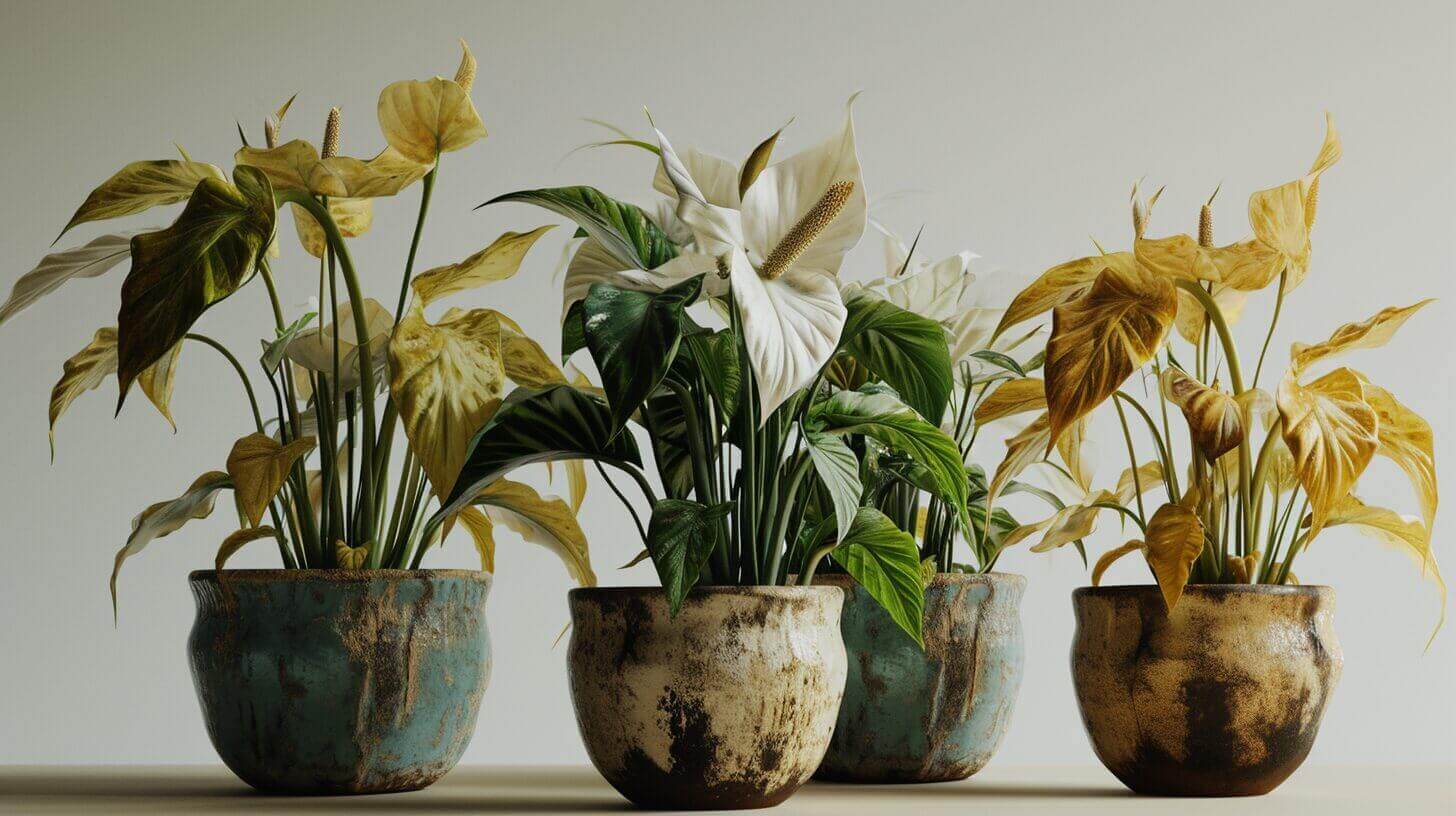Why Are My Peace Lily Leaves Turning Brown? Causes & Fixes Brown Leaves on Peace Lily
Have you ever wondered why your peace lily leaves are turning a less than appealing shade of brown? Fear not, in this article, we will uncover the root causes and provide effective fixes for this common issue.
From overwatering to nutrient deficiencies, we will explore all the possible culprits behind the browning leaves of your beloved peace lily.
So, if you’re ready to revive the vibrant green beauty of your plant, let’s dive in and discover the solutions together.
Key Takeaways
- Overwatering can lead to root rot and browning of peace lily leaves. To prevent overwatering, allow the top inch of soil to dry out before watering again, and use well-draining soil and a pot with drainage holes.
- Underwatering can negatively impact peace lily plant. Check the soil moisture level by sticking a finger about an inch deep into the soil and water when the soil feels dry at this depth to maintain plant health.
- Direct sunlight can cause leaf scorching and browning in peace lilies. Place them in bright, filtered light for optimal growth and avoid overexposure to direct sunlight to prevent leaf burn.
- Nutrient deficiencies can cause browning of peace lily leaves. Test soil pH regularly and adjust if necessary, and use balanced fertilizer with essential nutrients following recommended application rates and schedule.
Overwatering
Overwatering is a common horticultural mistake that can lead to the browning of peace lily leaves. While indoors peace lilies need moist soil, excessive watering can cause their roots to become waterlogged, leading to root rot and the subsequent discoloration of the leaves. To prevent overwatering, it is important to understand the signs and take appropriate measures.
One of the key signs of overwatering is yellowing leaves that eventually turn brown and wilt. Additionally, if the peace lily’s pot feels excessively heavy or the soil remains constantly wet, it indicates that the plant is receiving more water than it needs. To prevent overwatering, allow the top inch of soil to dry out before watering again. Ensure that the plant is potted in well-draining soil and choose a pot with drainage holes to avoid water accumulation.
When watering, aim to keep the soil evenly moist, but not soggy. It is better to underwater than to overwater, as peace lilies can tolerate slight drought. Consider using a moisture meter or sticking your finger into the soil to gauge the moisture level before watering.
Underwatering
Insufficient watering, characterized by dry soil and wilted leaves, can negatively impact the health and vitality of peace lilies, requiring a careful balance in the amount of water provided. While overwatering is a common concern, underwatering can also lead to issues for these popular houseplants.
Here are some key points to consider when it comes to underwatering peace lilies:
Watering frequency:
- Peace lilies prefer slightly moist soil, so it’s important to water them regularly.
- However, it’s equally important to avoid overwatering, as this can lead to root rot.
Moisture level:
- Check the moisture level of the soil by sticking your finger about an inch deep into the soil.
- If the soil feels dry at this depth, it’s time to water the peace lily.
- Alternatively, if the soil feels moist, it’s best to hold off on watering for a few more days.
Maintaining the right watering frequency and monitoring the moisture level will help prevent underwatering and ensure the health and beauty of your peace lilies. Remember, these plants are native to tropical regions where they receive consistent rainfall, so providing them with adequate water is essential for their well-being. By striking the right balance, you can enjoy vibrant and thriving peace lilies in your home.
Brown Leaf Tips on Peace Lily Houseplant(Exposure to Direct Sunlight)
To ensure optimal growth and prevent leaf scorching, it is crucial to carefully manage the exposure of peace lilies to direct sunlight. Peace lilies are known for their shade requirements and thrive in indirect light sources. Direct sunlight exposure can lead to leaf burn and browning, causing stress to the plant and hindering its overall health.
To better understand the impact of direct sunlight on peace lilies, let’s take a look at the following table:
| Light Exposure | Effects on Peace Lilies | Recommended Environment |
|---|---|---|
| Direct sunlight | Leaf scorching and burn | Avoid direct sunlight |
| Indirect sunlight | Optimal growth | Bright, filtered light |
| Low light | Stunted growth | Low-light areas |
By providing peace lilies with the right amount of light, we can help them thrive. Place them in a location where they receive bright, filtered light to ensure their well-being. If you notice browning or yellowing leaves, it may be a sign of overexposure to direct sunlight.
Understanding the impact of light exposure on peace lilies is important, as it transitions us into the subsequent discussion on nutrient deficiencies.
Brown Leaves on Peace Lily(Nutrient Deficiencies)
While light exposure plays a significant role in the health of peace lilies, another crucial aspect to consider is the potential impact of nutrient deficiencies. These deficiencies can result in the browning of peace lily leaves and can be attributed to two main factors: soil pH imbalance and improper fertilization.
Soil pH imbalance:
- Peace lilies thrive in slightly acidic to neutral soil conditions, with a pH range of 6.0 to 7.0. If the soil becomes too acidic or alkaline, it can hinder the plant’s ability to absorb essential nutrients, leading to deficiencies and subsequent leaf browning.
- To address this issue, regularly test the soil pH and adjust it accordingly. If the pH is too high, adding acidic amendments like peat moss or sulfur can help lower it. Conversely, if the pH is too low, adding lime or dolomite can raise it to the desired range.
Improper fertilization:
- Peace lilies require a balanced fertilizer that provides essential nutrients such as nitrogen, phosphorus, and potassium. Over-fertilization or using the wrong type of fertilizer can lead to nutrient imbalances and leaf browning.
- It is essential to follow the recommended fertilizer application rates and schedule. Using a slow-release fertilizer or diluted liquid fertilizer can help provide a steady supply of nutrients without overwhelming the plant.
Causes of Peace Lily Have Brown Leaves(Pest Infestation)
The peace lily’s health and foliage can be severely compromised if it becomes overrun by pests, such as aphids or spider mites, which need to be promptly dealt with using appropriate pest control measures.
One common symptom of a pest infestation in peace lilies is the presence of yellowing leaves. These pests feed on the plant’s sap, causing the leaves to lose their vibrant green color and turn yellow.
In addition to yellowing leaves, another sign of a pest infestation is wilting foliage. The pests can damage the plant’s roots, preventing it from taking up water properly, leading to wilting and drooping leaves.
To address a pest infestation in your peace lily, it is important to first identify the specific pest causing the problem. Once identified, appropriate pest control measures can be taken, such as washing the leaves with a mild soap solution or using insecticidal sprays.
It is also important to regularly inspect your peace lily for any signs of pests and promptly address any infestations to ensure the health and vitality of the plant.
Frequently Asked Questions
How Can I Prevent Yellow Leaves on My Peace Lily from Turning Brown?
Yellowing leaves on peace lily indicate a problem that needs attention. To prevent them from turning brown, maintain proper watering, allowing the soil to dry slightly between waterings. Avoid overexposure to direct sunlight and ensure the plant is placed in an area with low to medium light. Consider regular misting to increase humidity levels and occasional fertilization to provide essential nutrients.
Can I Use Tap Water to Water My Peace Lily?
Using tap water to water your plant may not be ideal. Tap water often contains minerals and chemicals that can build up in the soil and affect the health of the plant.
It is recommended to use filtered or distilled water for your peace lily. Filtered water removes impurities, while distilled water is free from minerals.
Both options provide benefits by ensuring the plant receives clean and pure water, which can help prevent browning of the leaves.
How Often Should I Fertilize My Peace Lily?
Fertilizing your peace lily is an important aspect of its overall care. The frequency at which you should fertilize depends on various factors such as the type of fertilizer used and the growth rate of your plant.
Generally, it is recommended to fertilize peace lilies every 2-4 weeks during the growing season, which is typically spring and summer. The best fertilizers for peace lilies are those specifically formulated for indoor plants, with a balanced ratio of nutrients.
Are There Any Natural Remedies for Treating Pests on My Peace Lily?
When it comes to dealing with pests on your peace lily, natural remedies can be quite effective.
Many people have found success using homemade pest repellents made from ingredients like neem oil, garlic, or vinegar.
These natural pest control methods not only help keep your peace lily healthy, but also ensure that you are not exposing yourself or the environment to harmful chemicals.
Why are my peace lily leaves turning brown?
Peace ilies are tropical plants, the leaves may turn brown for several common reasons, including overwatering, underwatering, exposure to direct sunlight, or a lack of humidity.
What causes the tips of peace lily leaves to turn brown?
Brown tips in peace lily leaf tips are often a result of over-fertilization or exposure to chemicals in tap water such as chlorine or fluoride.
How can I prevent my peace lily leaves from turning brown?
To prevent your peace lily leaves from turning brown, ensure the plant is watered properly, kept in indirect sunlight, and has adequate humidity.
Why is my peace lily flower turning brown?
Peace lily flowers can turn brown due to aging or if the plant is stressed due to factors like improper watering or exposure to extreme temperatures.
Are yellow leaves a sign of a problem in peace lilies?
Yes, yellow leaves can be a sign of overwatering or poor drainage in peace lilies. It could also indicate a lack of necessary nutrients.
How can I treat brown leaves on my peace lily?
To treat brown leaves on your peace lily, identify the cause first. If it’s due to overwatering, adjust your watering schedule. If it’s due to exposure to direct sunlight, move the plant to a location with indirect light.
Can repotting help with my peace lily’s brown leaves?
Yes, repotting can help if the browning is caused by root-related issues like root rot. Fresh soil can provide better drainage and prevent waterlogging.
Why are the leaf tips on my peace lily turning brown?
The leaf tips on your peace lily could be turning brown due to a lack of humidity or over-fertilization. It could also be due to exposure to chemicals in tap water.
Is it normal for a peace lily flower to turn brown?
While it’s normal for a peace lily flower to eventually turn brown as it ages, premature browning could be a sign of stress due to factors like improper watering or exposure to extreme temperatures.
What should I do if my peace lily is turning yellow and brown?
If your peace lily is turning yellow and brown, it might be due to overwatering or poor drainage. Adjust your watering schedule and ensure the plant has good drainage. If the problem persists, consider repotting the plant.







